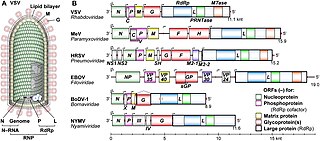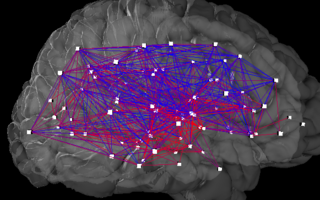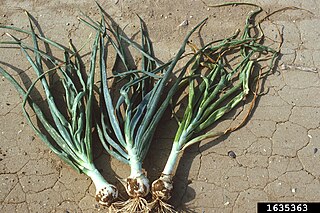Related Research Articles

Mononegavirales is an order of negative-strand RNA viruses which have nonsegmented genomes. Some common members of the order are Ebola virus, human respiratory syncytial virus, measles virus, mumps virus, Nipah virus, and rabies virus. All of these viruses cause significant disease in humans. Many other important pathogens of nonhuman animals and plants are also in the group. The order includes eleven virus families: Artoviridae, Bornaviridae, Filoviridae, Lispiviridae, Mymonaviridae, Nyamiviridae, Paramyxoviridae, Pneumoviridae, Rhabdoviridae, Sunviridae, and Xinmoviridae.

Mimivirus is a genus of giant viruses, in the family Mimiviridae. Amoeba serve as their natural hosts. This genus contains a single identified species named Acanthamoeba polyphaga mimivirus (APMV). It also refers to a group of phylogenetically related large viruses.
A satellite is a subviral agent that depends on the coinfection of a host cell with a helper virus for its replication. Satellites can be divided into two major classes: satellite viruses and satellite nucleic acids. Satellite viruses, which are most commonly associated with plants, are also found in mammals, arthropods, and bacteria. They encode structural proteins to enclose their genetic material, which are therefore distinct from the structural proteins of their helper viruses. Satellite nucleic acids, in contrast, do not encode their own structural proteins, but instead are encapsulated by proteins encoded by their helper viruses. The genomes of satellites range upward from 359 nucleotides in length for satellite tobacco ringspot virus RNA (STobRV).

Metagenomics is the study of genetic material recovered directly from environmental samples. The broad field may also be referred to as environmental genomics, ecogenomics or community genomics.
DPVweb is a database for virologists working on plant viruses combining taxonomic, bioinformatic and symptom data.
Idaeovirus is a genus of positive-sense ssRNA viruses that contains two species: Raspberry bushy dwarf virus (RBDV) and Privet idaeovirus. RBDV has two host-dependent clades: one for raspberries; the other for grapevines. Infections are a significant agricultural burden, resulting in decreased yield and quality of crops. RBDV has a synergistic relation with Raspberry leaf mottle virus, with co-infection greatly amplifying the concentration of virions in infected plants. The virus is transmitted via pollination with RBDV-infected pollen grains that first infect the stigma before causing systemic infection.
Connectomics is the production and study of connectomes: comprehensive maps of connections within an organism's nervous system. More generally, it can be thought of as the study of neuronal wiring diagrams with a focus on how structural connectivity, individual synapses, cellular morphology, and cellular ultrastructure contribute to the make up of a network. The nervous system is a network made of billions of connections and these connections are responsible for our thoughts, emotions, actions, memories, function and dysfunction. Therefore, the study of connectomics aims to advance our understanding of mental health and cognition by understanding how cells in the nervous system are connected and communicate. Because these structures are extremely complex, methods within this field use a high-throughput application of functional and structural neural imaging, most commonly magnetic resonance imaging (MRI), electron microscopy, and histological techniques in order to increase the speed, efficiency, and resolution of these nervous system maps. To date, tens of large scale datasets have been collected spanning the nervous system including the various areas of cortex, cerebellum, the retina, the peripheral nervous system and neuromuscular junctions.
Alternanthera mosaic virus (AltMV) is a plant pathogenic virus. AltMV belongs to the virus genus Potexvirus and the virus family Alphaflexiviridae.

Mimivirus-dependent virus Sputnik is a subviral agent that reproduces in amoeba cells that are already infected by a certain helper virus; Sputnik uses the helper virus's machinery for reproduction and inhibits replication of the helper virus. It is known as a virophage, in analogy to the term bacteriophage.

A giant virus, sometimes referred to as a girus, is a very large virus, some of which are larger than typical bacteria. All known giant viruses belong to the phylum Nucleocytoviricota.

Marseilleviridae is a family of viruses first named in 2012. The genomes of these viruses are double-stranded DNA. Amoeba are often hosts, but there is evidence that they are found in humans as well. The family contains one genus and four species, two of which are unassigned to a genus. It is a member of the nucleocytoplasmic large DNA viruses clade.

Mavirus is a genus of double stranded DNA virus that can infect the marine phagotrophic flagellate Cafeteria roenbergensis, but only in the presence of the giant CroV virus. The genus contains only one species, Cafeteriavirus-dependent mavirus. Mavirus can integrate into the genome of cells of C. roenbergensis, and thereby confer immunity to the population
Daphne virus S (DVS) is a plant virus that infects daphnes. Infection causes leaf distortion and chlorotic spot disease symptoms. Its genome is about 8,700 nucleotides in length and contains six open reading frames that encode for a viral replicase, a triple gene block and capsid proteins.
Nerine latent virus (NeLV) is a plant pathogenic virus. It infects Nerine, Narcissus, Hippeastrum and Ismene plants.
Amalgaviridae is a family of double-stranded RNA viruses. Member viruses infect plants and are transmitted vertically via seeds. The name derives from amalgam which refers to amalgaviruses possessing characteristics of both partitiviruses and totiviruses. There are ten species in the family.

The Budapest Reference Connectome server computes the frequently appearing anatomical brain connections of 418 healthy subjects. It has been prepared from diffusion MRI datasets of the Human Connectome Project into a reference connectome, which can be downloaded in CSV and GraphML formats and visualized on the site in 3D.
Banana streak MY virus (BSMYV) is a plant virus that causes banana streak disease of banana (Musa) species, which results in chlorotic streaks in the leaves and a reduced crop. The virus has been recovered from Australia, India and Tonga. It is composed of a double-stranded DNA genome and may exist in either an infectious episomal form or an endogenous form which is integrated into the host DNA. It is spread by several species of mealy bug.

Genomoviridae is a family of single stranded DNA viruses that mainly infect fungi. The genomes of this family are small. The genomes are circular single-stranded DNA and encode rolling-circle replication initiation proteins (Rep) and unique capsid proteins. In Rep-based phylogenies, genomoviruses form a sister clade to plant viruses of the family Geminiviridae. Ten genera are recognized in this family.
Smacoviridae is a family of single-stranded DNA viruses. The genomes of this family are small. The name Smacoviridae stands for 'small circular genome virus'. The genomes are circular single-stranded DNA and encode rolling-circle replication initiation proteins (Rep) and unique capsid proteins. As of 2021, 12 genera and 84 species are recognized in this family. The viruses in this taxon were isolated from faecal samples from insects and vertebrates by metagenomic methods. Little is known about their biology.

Onion yellow dwarf virus (OYDV) is a plant virus in the genus Potyvirus that has been identified worldwide and mainly infects species of Allium such as onion, garlic, and leek. The virus causes mild to severe leaf malformation, and bulb reduction up to sixty percent has been observed in garlic.
References
- ↑ Kerepesi, Csaba; Grolmusz, Vince (2016). "Giant Viruses of the Kutch Desert". Archives of Virology. 161 (3): 721–724. arXiv: 1410.1278 . doi:10.1007/s00705-015-2720-8. PMID 26666442. S2CID 13145926.
- ↑ Kerepesi, Csaba; Grolmusz, Vince (2017). "The "Giant Virus Finder" Discovers an Abundance of Giant Viruses in the Antarctic Dry Valleys". Archives of Virology. 162 (6): 1671–1676. arXiv: 1503.05575 . doi:10.1007/s00705-017-3286-4. PMID 28247094. S2CID 1925728.